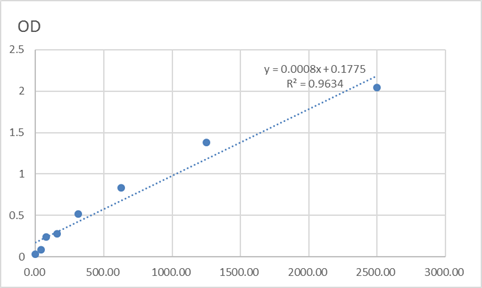Total Casein Kinase Iε Cell-Based Colorimetric ELISA Kit
- Catalog No.:KA3617C
- Applications:ELISA
- Reactivity:Human;Mouse
- Gene Name:
- CSNK1E
- Human Gene Id:
- 102800317
- Human Swiss Prot No:
- P49674
- Mouse Swiss Prot No:
- Q9JMK2
- Storage Stability:
- 2-8°C/6 months
- Other Name:
- Casein kinase I isoform epsilon (CKI-epsilon) (CKIe) (EC 2.7.11.1)
- Detection Method:
- Colorimetric
- Background:
- catalytic activity:ATP + a protein = ADP + a phosphoprotein.,function:Casein kinases are operationally defined by their preferential utilization of acidic proteins such as caseins as substrates. Can phosphorylate a large number of proteins. Participates in Wnt signaling. Phosphorylates DVL1. Central component of the circadian clock. May act as a negative regulator of circadian rhythmicity by phosphorylating PER1 and PER2. Retains PER1 in the cytoplasm. Inhibits cytokine-induced granuloytic differentiation.,induction:Down-regulated during granulocytic differentiation.,PTM:Autophosphorylated.,similarity:Belongs to the protein kinase superfamily.,similarity:Belongs to the protein kinase superfamily. CK1 Ser/Thr protein kinase family. Casein kinase I subfamily.,similarity:Contains 1 protein kinase domain.,subunit:Monomer. Component of the circadian core oscillator, which includes the CRY proteins, CLOCK, or NPAS2, BMAL1 or BMAL2, CSNK1D and/or CSNK1E, TIMELESS and the PER proteins. Interacts directly with PER1 and PER2 which may lead to their degradation. Interacts with ANKRD6 and SOCS3.,tissue specificity:Expressed in all tissues examined, including brain, heart, lung, liver, pancreas, kidney, placenta and skeletal muscle. Expressed in monocytes and lymphocytes but not in granulocytes.,
- Function:
- DNA metabolic process, DNA repair, protein amino acid phosphorylation, phosphorus metabolic process, phosphate metabolic process, response to DNA damage stimulus, phosphorylation, cellular response to stress,
- Subcellular Location:
- Cytoplasm . Nucleus .
- Expression:
- Expressed in all tissues examined, including brain, heart, lung, liver, pancreas, kidney, placenta and skeletal muscle. Expressed in monocytes and lymphocytes but not in granulocytes.
- June 19-2018
- WESTERN IMMUNOBLOTTING PROTOCOL
- June 19-2018
- IMMUNOHISTOCHEMISTRY-PARAFFIN PROTOCOL
- June 19-2018
- IMMUNOFLUORESCENCE PROTOCOL
- September 08-2020
- FLOW-CYTOMEYRT-PROTOCOL
- May 20-2022
- Cell-Based ELISA│解您多样本WB检测之困扰
- July 13-2018
- CELL-BASED-ELISA-PROTOCOL-FOR-ACETYL-PROTEIN
- July 13-2018
- CELL-BASED-ELISA-PROTOCOL-FOR-PHOSPHO-PROTEIN
- July 13-2018
- Antibody-FAQs



